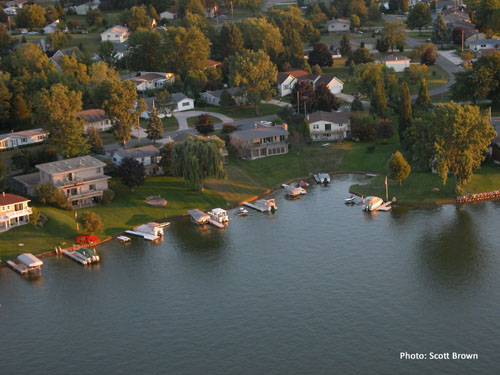Landscaping important to maintaining health of shorelines
“Natural Shoreline Landscapes on Michigan’s Inland Lakes: Guidebook for Property Owners,” provides guidance on lake-friendly natural shoreline landscaping.
 Intense development can compromise the ability of shorelines to support the fish, wildlife and clean water that attract people to Michigan’s 11,000 inland lakes. High-impact lakefront landscaping, with lawn to the water’s edge, creates problems for the lake ecosystem and for waterfront property owners. Rainwater carries lawn fertilizers, pesticides, pet waste and grass clippings into the lake. These pollutants can promote nuisance aquatic plant growth and create water quality concerns. Plants with shallow roots, such as turf grass, cannot withstand wave and ice action and allow the shoreline to erode. Vertical sea walls and heavy rock riprap destroy sensitive shoreline and near shore habitats. Perfectly manicured lawns attract nuisance wildlife species, such as geese.
Intense development can compromise the ability of shorelines to support the fish, wildlife and clean water that attract people to Michigan’s 11,000 inland lakes. High-impact lakefront landscaping, with lawn to the water’s edge, creates problems for the lake ecosystem and for waterfront property owners. Rainwater carries lawn fertilizers, pesticides, pet waste and grass clippings into the lake. These pollutants can promote nuisance aquatic plant growth and create water quality concerns. Plants with shallow roots, such as turf grass, cannot withstand wave and ice action and allow the shoreline to erode. Vertical sea walls and heavy rock riprap destroy sensitive shoreline and near shore habitats. Perfectly manicured lawns attract nuisance wildlife species, such as geese.
Alternative landscaping solutions can create attractive waterfronts that provide access to the lake while providing the ecosystem services of an undeveloped, natural shoreline. These services include improved fish and wildlife habitat (including songbirds and butterflies), reduced runoff and shoreline erosion control.
An MSU Extension Bulletin E-3145, "Natural Shoreline Landscapes on Michigan’s Inland Lakes: Guidebook for Property Owners" is available from the MSUE Bookstore. This well-illustrated publication from the Michigan Natural Shoreline Partnership is an excellent source of information and guidance on natural shoreline design and native shoreline plants.



 Print
Print Email
Email

